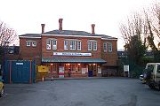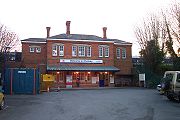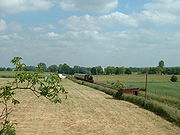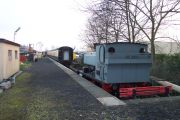
Cholsey and Wallingford Railway
Encyclopedia




Standard gauge
The standard gauge is a widely-used track gauge . Approximately 60% of the world's existing railway lines are built to this gauge...
heritage railway
Heritage railway
thumb|right|the Historical [[Khyber train safari|Khyber Railway]] goes through the [[Khyber Pass]], [[Pakistan]]A heritage railway , preserved railway , tourist railway , or tourist railroad is a railway that is run as a tourist attraction, in some cases by volunteers, and...
in the English
England
England is a country that is part of the United Kingdom. It shares land borders with Scotland to the north and Wales to the west; the Irish Sea is to the north west, the Celtic Sea to the south west, with the North Sea to the east and the English Channel to the south separating it from continental...
county of Oxfordshire
Oxfordshire
Oxfordshire is a county in the South East region of England, bordering on Warwickshire and Northamptonshire , Buckinghamshire , Berkshire , Wiltshire and Gloucestershire ....
. It operates along most of the length of the former Wallingford branch of the Great Western Railway
Great Western Railway
The Great Western Railway was a British railway company that linked London with the south-west and west of England and most of Wales. It was founded in 1833, received its enabling Act of Parliament in 1835 and ran its first trains in 1838...
(GWR), from Cholsey station
Cholsey railway station
Cholsey railway station, previously known as Cholsey and Moulsford railway station, is a railway station located in the village of Cholsey in Oxfordshire in England...
, 12 miles (19.3 km) north of Reading
Reading, Berkshire
Reading is a large town and unitary authority area in England. It is located in the Thames Valley at the confluence of the River Thames and River Kennet, and on both the Great Western Main Line railway and the M4 motorway, some west of London....
on the Great Western Main Line
Great Western Main Line
The Great Western Main Line is a main line railway in Great Britain that runs westwards from London Paddington station to the west of England and South Wales. The core Great Western Main Line runs from London Paddington to Temple Meads railway station in Bristol. A major branch of the Great...
, to a station on the outskirts of the nearby town of Wallingford.
History
The first plans for the Cholsey to Wallingford line date from 1861, and envisaged an independently owned route from MoulsfordMoulsford
Moulsford is a village and civil parish in South Oxfordshire. In 1974 it was transferred from Berkshire to the county of Oxfordshire, and from Wallingford Rural District to the district of South Oxfordshire....
to Princes Risborough
Princes Risborough
Princes Risborough is a small town in Buckinghamshire, England, about 9 miles south of Aylesbury and 8 miles north west of High Wycombe. Bledlow lies to the west and Monks Risborough to the east. It lies at the foot of the Chiltern Hills, at the north end of a gap or pass through the Chilterns,...
via Wallingford, Benson
Benson, Oxfordshire
Benson is a village and civil parish in South Oxfordshire, England. It is about north of Wallingford at the foot of the Chiltern Hills at the confluence of a chalk stream and the River Thames, next to Benson Lock...
, Watlington
Watlington, Oxfordshire
Watlington is a market town and civil parish about south of Thame in Oxfordshire. The parish includes the hamlets of Christmas Common and Greenfield, both of which are in the Chiltern Hills. The M40 motorway is from Watlington.-History:...
and Chinnor
Chinnor
Chinnor is a village and civil parish in South Oxfordshire about southeast of Thame. The village is a Spring line settlement on the Icknield Way below the Chiltern escarpment...
. This line was a through route, with junctions with the Great Western Railway at both Moulsford and Princes Risborough. By 1863 the plans had been amended to run from a junction nearer Cholsey than Moulsford, and to run only as far as Watlington.
The Wallingford and Watlington Railway opened as far as Wallingford in 1866, but poor traffic receipts meant that the planned extension to Watlington was given up in 1868 and the line never reached further than Wallingford. The railway was sold to the GWR in 1872 and, for reasons now forgotten, the line became popularly known as the Wallingford Bunk. The line closed to passengers in 1959, and the last goods traffic into the old Wallingford Station ran in 1965.
However most of the line was retained to serve a maltings adjacent to the railway on the outskirts of Wallingford. Rail service to this plant ceased in 1981, at which point the Cholsey and Wallingford Railway Preservation Society was formed to revive the line for tourist services. It first ran train rides for the public in 1985, with regular advertised services over the full available length of the line beginning in 1997. Steam traction has also been reintroduced.
Services
Most services on the line are currently hauled by diesel locomotiveDiesel locomotive
A diesel locomotive is a type of railroad locomotive in which the prime mover is a diesel engine, a reciprocating engine operating on the Diesel cycle as invented by Dr. Rudolf Diesel...
s, and run on occasional weekends
Workweek
The workweek and weekend are those complementary parts of the week devoted to labour and rest respectively. The legal working week , or workweek , is the part of the seven-day week devoted to labor. In most Western countries it is Monday to Friday. The weekend comprises the two traditionally...
and bank holiday
Bank Holiday
A bank holiday is a public holiday in the United Kingdom or a colloquialism for public holiday in Ireland. There is no automatic right to time off on these days, although the majority of the population is granted time off work or extra pay for working on these days, depending on their contract...
s. The railway's web site has details on operating days.
The original branch platform at Cholsey station
Cholsey railway station
Cholsey railway station, previously known as Cholsey and Moulsford railway station, is a railway station located in the village of Cholsey in Oxfordshire in England...
is still available to the preserved railway, and trains connect here with First Great Western
First Great Western
First Great Western is the operating name of First Greater Western Ltd, a British train operating company owned by FirstGroup that serves Greater London, the South East, South West and West Midlands regions of England, and South Wales....
stopping services on the Great Western Main Line
Great Western Main Line
The Great Western Main Line is a main line railway in Great Britain that runs westwards from London Paddington station to the west of England and South Wales. The core Great Western Main Line runs from London Paddington to Temple Meads railway station in Bristol. A major branch of the Great...
between Reading
Reading railway station
Reading railway station is a major rail transport hub in the English town of Reading. It is situated on the northern edge of the town centre, close to the main retail and commercial areas, and also the River Thames...
and Didcot
Didcot Parkway railway station
Didcot Parkway is a railway station serving the town of Didcot in Oxfordshire in England. The station was opened as Didcot on 12 June 1844, and renamed Didcot Parkway on 29 July 1985 to reflect its role as a park and ride railhead....
stations.
However the original Wallingford railway station and the last segment of the line have long been built on, and the line now terminates at a makeshift station at the line's headquarters adjacent to the site of the maltings that kept the line alive into the preservation era. The maltings have recently been demolished and replaced by housing, releasing some extra land to the railway. There are plans to build a replica GWR style station on this land.
Steam
Visiting steam locomotive for 2011 is Southall Railway CentreSouthall Railway Centre
Southall Railway Centre is a railway heritage centre at Southall in west London, near to Southall railway station and the Grand Union Canal. It is run by the GWR Preservation Group Limited .-History:...
's "Birkenhead" from 29 May 2011.
Diesel
Sunday, 31 July 2011 - South Oxfordshire Diesel Day to be held jointly with Didcot Railway CentreDidcot Railway Centre
Didcot Railway Centre, located in the town of Didcot in the English county of Oxfordshire, is based around the site of a comprehensive "engine shed" which became redundant after the nationalisation of the UK railways, due to the gradual changeover from steam to diesel motive power.-Description:The...
.
Locomotives
The line is the home to several diesel locomotiveDiesel locomotive
A diesel locomotive is a type of railroad locomotive in which the prime mover is a diesel engine, a reciprocating engine operating on the Diesel cycle as invented by Dr. Rudolf Diesel...
s, including three of British Rail
British Rail
British Railways , which from 1965 traded as British Rail, was the operator of most of the rail transport in Great Britain between 1948 and 1997. It was formed from the nationalisation of the "Big Four" British railway companies and lasted until the gradual privatisation of British Rail, in stages...
's ubiquitous Class 08
British Rail Class 08
The British Rail Class 08 is a class of diesel-electric shunting locomotive. From 1953 to 1962, 996 locomotives were produced, making it the most numerous of all British locomotive classes....
shunters
Switcher
A switcher or shunter is a small railroad locomotive intended not for moving trains over long distances but rather for assembling trains ready for a road locomotive to take over, disassembling a train that has been...
, which are used on most trains. Whilst the line does not currently possess any steam locomotive
Steam locomotive
A steam locomotive is a railway locomotive that produces its power through a steam engine. These locomotives are fueled by burning some combustible material, usually coal, wood or oil, to produce steam in a boiler, which drives the steam engine...
s, it is occasionally operated by visiting steam locomotives, see "Special events" above.
- British Rail Class 08British Rail Class 08The British Rail Class 08 is a class of diesel-electric shunting locomotive. From 1953 to 1962, 996 locomotives were produced, making it the most numerous of all British locomotive classes....
0-6-00-6-0Under the Whyte notation for the classification of steam locomotives, 0-6-0 represents the wheel arrangement of no leading wheels, six powered and coupled driving wheels on three axles, and no trailing wheels...
DE 08022 Lion, ex-GuinnessGuinnessGuinness is a popular Irish dry stout that originated in the brewery of Arthur Guinness at St. James's Gate, Dublin. Guinness is directly descended from the porter style that originated in London in the early 18th century and is one of the most successful beer brands worldwide, brewed in almost...
Brewery, Park RoyalPark RoyalPark Royal is an area in northwest London, UK. It is the largest industrial and business park in London, occupying about , and is promoted commercially by the Park Royal Partnership...
, LondonLondonLondon is the capital city of :England and the :United Kingdom, the largest metropolitan area in the United Kingdom, and the largest urban zone in the European Union by most measures. Located on the River Thames, London has been a major settlement for two millennia, its history going back to its...
(operational, July 2011) - British Rail Class 08 0-6-0DE 08060 Unicorn, ex-Guinness Brewery, Park Royal, London (operational, July 2011)
- British Rail Class 08 0-6-0DE 08123 George Mason (operational, July 2011)
- HibberdF. C. Hibberd & Co LtdF. C. Hibberd & Co Ltd was a British locomotive-building company founded in 1927 to build industrial petrol and diesel locomotives. In 1932 the company acquired the goodwill of James and Frederick Howard Ltd...
0-4-00-4-0Under the Whyte notation for the classification of steam locomotives, 0-4-0 represents one of the simplest possible types, that with two axles and four coupled wheels, all of which are driven...
DM Carpenter, ex-Guinness Brewery, Park Royal, London (under repair, July 2011)
Non-CWR locomotives
A temporary resident is an American-built diesel locomotive which is owned by The American Railroad Centre in the UK:
- Alco S-1ALCO S-1 and S-3The ALCO S-1 and S-3 were switcher diesel-electric locomotives produced by ALCO and their Canadian subsidiary Montreal Locomotive Works . Basically, the two locomotives differed only in trucks, with the S-1 using ALCO's own Blunt trucks, and the S-3 riding on standard AAR type A switcher trucks...
Bo-BoBo-BoA Bo-Bo or Bo′Bo′ is a locomotive with two independent four-wheeled bogies with all axles powered by individual traction motors...
DE No. 77777 (built 1949/50), ex-Steel Company of WalesSteel Company of WalesThe Steel Company of Wales Ltd was a Welsh steel and tinplate producer. It was formed in 1947 and absorbed into British Steel in 1967. The business now forms part of Corus, a subsidiary of Tata Steel....
No. 803
Notes
- DE = diesel-electric
- DM = diesel mechanicalDiesel locomotiveA diesel locomotive is a type of railroad locomotive in which the prime mover is a diesel engine, a reciprocating engine operating on the Diesel cycle as invented by Dr. Rudolf Diesel...

